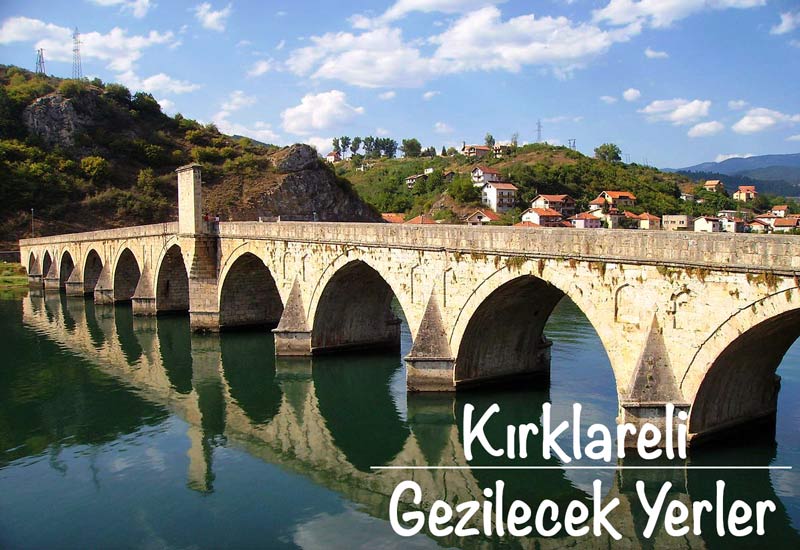One of the oldest settlements of Thrace, Kırklareli attracts thousands of local and foreign tourists every year with its natural beauties as well as its many historical and cultural values in its center and districts. attracts attention. In Kırklareli, one of the border cities of Turkey, it is possible to see artifacts from every period, and when natural beauties are added to these, it is not possible to leave the city..
Places to Visit in Kırklareli
To categorize the places to visit during a Kırklareli trip; You can sort ruins and museums, mosques, social complexes, places of worship, fountains, martyrdoms, bastions, caves, coves and castles.
RUSSIS AND MUSEUMS
As a result of the excavations in the Aşağıpınar Tumulus, located in the southern part of the city, at a distance of meters from the center of Kırklareli, it was found that the Mound. HE. It was concluded that there was a settlement between 6500 and 4300 years.. The traces of the Neolithic period show that the Neolithic period culture spread to the Balkans and then to Europe through Thrace. Asagipınar Tumulus has become one of the places that attract the attention of tourists today due to its traces that it was the first settlement in Thrace.. Another archaeological site, approximately 300 meters from Aşağıpınar Tumulus, is Kanlıgeçit Tumulus.. M. HE. Similar to Aşağıpınar Tumulus, it has an important place in the chronology of Balkan history due to the traces of settlements determined to belong to the 3600s.. The findings, which contain structures made of wood and branches, are exhibited in the Kırklareli museum today.
M. HE. 14 and 13. Starting with the last periods of the Bronze Age, which coincides with the end of the century, M.. S. 3. Although it has been determined that the number of Tumuli, which is a structure that lasted until the century, is around 200, only 92 of them have been registered today, about 50 of them are located within the borders of the Visa district.. The fact that these structures, which are usually made of earth and embossed in the shape of a mound, have a burial chamber, show that the peoples living in the region had a culture of immortalizing the structures by burying their dead. Dolmens, which are structures made of flat large stones and designed as burial chambers, located on the mountainous and forested area between Edirne’sLalapaşa district and Kırklareli’s Demirköy district, are also known as the tumulus remains for Kapaklıkayalar. M. HE. The region has come to a very important position in terms of showing the period between 1300 and 800.
The Kırklareli Museum, where the remains of historical periods are exhibited, was used as the town hall when it was built in 1894, and a museum in 1994. has been made into. Archaeological and ethnographic artifacts are exhibited in the 2-storey museum, which has another floor apart from the nature hall on the ground floor, which is the most interesting and most interesting part of the museum. strong>
There are 5 mosques in the region that are open to worship today.. Of these, first,; located in the center, 16. The Beyazıt mosque, which was built in the 16th century and has a square plan, is the second; Kapan Mosque, also known as İbrahim Bey Mosque, was built in 1640 at the corner where Mustafa Kemal Boulevard intersects with Pınarhisar road. Although its original form was square in plan, it has lost its originality due to the restoration process it has gone through. strong>; It is the Kadı Mosque, which is located in the center of Kırklareli and has a square plan, built by Emin Ali Çelebi in 1577. It is the fourth; It is the square planned Karakaşbey Mosque, which was built by Karakaş Hacı Mehmet Bey in 1628, the fifth one; It is the Üsküpdere Mosque, which was built in 1904 and has a rectangular plan and is located in Üsküpdere village. Located in the grove in the north of the city within the borders of Kırklareli , Namazgah is among the places to be seen..
FOUNTAINS
There are 11 fountains with historical value in Kırklareli. Of these, first; 19. The German Fountain, adjoining the wall of the Great Mosque, built in a Neo-Classical style at the end of the century, the second one; The Painter’s Fountain, which was built in 1771 and is located on the Namazgah avenue, is the third; 19. In the second half of the century, the Prison Fountain, which is located right next to the old two-storey prison building, is the fourth; 19. At the end of the century, the Gerdanlı Fountain with two different surfaces, located on Tırnova Caddesi Acem Geçidi Sokak, is the fifth; 16. The Kadı Fountain, built in the middle of the century, located opposite the Kadı Mosque, is the sixth; The Kapan Fountain, built in 1771 and located in front of the Kapan Mosque, is the seventh; The Karaumurbey Fountain, built in 1844 and located on Karaumur Street, is the eighth; The Kayyumoğlu Fountain, built in 1768 on the Pınarhisar road, is the ninth; 19. The Kocahidir Fountain, which was built on the Pınarhisar road in the second half of the century, is the tenth one; Located on Kurupaşa Çeşme Street, the Pasha Fountain is the eleventh; 19. It is the Söğütlü Fountain built in the Söğütlük location in the second half of the century.
HISTORIC BUILDINGS
The city is rich in historical buildings, and the Pinarhisar Castle, Vize Castle, Hızırbey Complex , Little Hagia Sophia Church, Cave Monastery, Aya Nikola Monastery, Babaeski Bridge and Alpullu Bridge are among the main monuments that can be visited.
TOWNS
Kırklareli is a region preferred by holidaymakers in summer months due to its geographical location. Places such as Begendik Village, Balkaya Village, Igneada, Igneada Longozu, Igneada Limankoy, Kiyikoy Castro Coast and Lüleburgaz are areas worth seeing during your visit to Kirklareli.







